Epitaxial CdSe/PbSe Heterojunction Growth and MWIR Photovoltaic Detector
Abstract
1. Introduction
2. Experimental Methods
2.1. Epitaxial Heterojunction Growth
2.2. Epitaxial Heterojunction Growth
3. Results and Discussion
3.1. Crystallography and Surface Morphology of Epitaxial CdSe Films on PbSe
3.2. Current-Voltage and Radiometric Measurements
4. Conclusions
Author Contributions
Funding
Institutional Review Board Statement
Informed Consent Statement
Data Availability Statement
Acknowledgments
Conflicts of Interest
References
- Qiu, J.; Weng, B.; Yuan, Z.; Shi, Z. Study of Sensitization Process on Mid-Infrared Uncooled PbSe Photoconductive Detectors Leads to High Detectivity. J. Appl. Phys. 2013, 113, 103102. [Google Scholar] [CrossRef]
- Zhao, L.; Qiu, J.; Weng, B.; Chang, C.; Yuan, Z.; Shi, Z. Understanding Sensitization Behavior of Lead Selenide Photoconductive Detectors by Charge Separation Model. J. Appl. Phys. 2014, 115, 084502. [Google Scholar] [CrossRef]
- Weng, B.; Qiu, J.; Yuan, Z.; Larson, P.R.; Strout, G.W.; Shi, Z. Responsivity Enhancement of Mid-Infrared PbSe Detectors Using CaF 2 Nano-Structured Antireflective Coatings. Appl. Phys. Lett. 2014, 104, 021109. [Google Scholar] [CrossRef]
- Green, K.; Yoo, S.-S.; Kauffman, C. Lead Salt TE-Cooled Imaging Sensor Development; Andresen, B.F., Fulop, G.F., Hanson, C.M., Norton, P.R., Eds.; SPIE: Baltimore, MD, USA, 24 June 2014; p. 90701G. [Google Scholar]
- Klann, R.; Höfer, T.; Buhleier, R.; Elsaesser, T.; Tomm, J.W. Fast Recombination Processes in Lead Chalcogenide Semiconductors Studied via Transient Optical Nonlinearities. J. Appl. Phys. 1995, 77, 277–286. [Google Scholar] [CrossRef]
- Findlay, P.C.; Pidgeon, C.R.; Kotitschke, R.; Hollingworth, A.; Murdin, B.N.; Langerak, C.J.G.M.; van der Meer, A.F.G.; Ciesla, C.M.; Oswald, J.; Homer, A.; et al. Auger Recombination Dynamics of Lead Salts under Picosecond Free-Electron-Laser Excitation. Phys. Rev. B 1998, 58, 12908–12915. [Google Scholar] [CrossRef]
- Ziep, O.; Mocker, M.; Genzow, D.; Herrmann, K.H. Auger recombination in PbSnTe-like semiconductors. Phys. Stat. Sol. B 1978, 90, 197–205. [Google Scholar] [CrossRef]
- Youngdale, E.R.; Meyer, J.R.; Hoffman, C.A.; Bartoli, F.J.; Grein, C.H.; Young, P.M.; Ehrenreich, H.; Miles, R.H.; Chow, D.H. Auger Lifetime Enhancement in InAs–Ga1−xInx Sb Superlattices. Appl. Phys. Lett. 1994, 64, 3160–3162. [Google Scholar] [CrossRef]
- Meyer, J.R.; Felix, C.L.; Bewley, W.W.; Vurgaftman, I.; Aifer, E.H.; Olafsen, L.J.; Lindle, J.R.; Hoffman, C.A.; Yang, M.-J.; Bennett, B.R.; et al. Auger Coefficients in Type-II InAs/Ga1−xInxSb Quantum Wells. Appl. Phys. Lett. 1998, 73, 2857–2859. [Google Scholar] [CrossRef]
- Ciesla, C.M.; Murdin, B.N.; Phillips, T.J.; White, A.M.; Beattie, A.R.; Langerak, C.J.G.M.; Elliott, C.T.; Pidgeon, C.R.; Sivananthan, S. Auger Recombination Dynamics of Hg0.795Cd0.205Te in the High Excitation Regime. Appl. Phys. Lett. 1997, 71, 491–493. [Google Scholar] [CrossRef]
- Beattie, A.R.; White, A.M. An Analytic Approximation with a Wide Range of Applicability for Electron Initiated Auger Transitions in Narrow-Gap Semiconductors. J. Appl. Phys. 1996, 79, 802. [Google Scholar] [CrossRef]
- Ganguly, S.; Tang, X.; Yoo, S.-S.; Guyot-Sionnest, P.; Ghosh, A.W. Extrinsic Voltage Control of Effective Carrier Lifetime in Polycrystalline PbSe Mid-Wave IR Photodetectors for Increased Detectivity. AIP Adv. 2020, 10, 095117. [Google Scholar] [CrossRef]
- Yang, H.; Wang, G.; Li, X.; Zheng, J. Effect of in Situ O+ Beam Induction on the Microstructures and Optical Properties of Polycrystalline Lead Selenide Films. Mater. Lett. 2019, 251, 85–88. [Google Scholar] [CrossRef]
- Qiu, J.; Liu, Y.; Zhang, G.; Shi, K.; Li, Y.; Luo, Y. Modified Vapor Phase Deposition Technology for High-Performance Uncooled MIR PbSe Detectors. RSC Adv. 2021, 11, 34908–34914. [Google Scholar] [CrossRef] [PubMed]
- Kumar, P.; Pfeffer, M.; Schweda, E.; Eibl, O.; Qiu, J.; Shi, Z. PbSe Mid-IR Photoconductive Thin Films (Part I): Phase Analysis of the Functional Layer. J. Alloys Compd. 2017, 724, 316–326. [Google Scholar] [CrossRef]
- Kumar, P.; Pfeffer, M.; Berthold, C.; Eibl, O. PbSe Mid-IR Photoconductive Thin Films (Part-II): Structural Analysis of the Functional Layer. J. Alloys Compd. 2018, 735, 1654–1661. [Google Scholar] [CrossRef]
- Wu, H.; Si, J.; Xu, T.; Cao, C. Progress of IV-VI Semiconductor Research in China. In Proceedings of the 2006 Joint 31st International Conference on Infrared Millimeter Waves and 14th International Conference on Teraherz Electronics, Shanghai, China, 18–22 September 2006; IEEE: Shanghai, China; p. 407. [Google Scholar]
- Yang, H.; Li, X.; Wang, G.; Zheng, J. The Electrical Properties of Carrier Transport between Lead Selenide Polycrystallites Manipulated by Iodine Concentration. AIP Adv. 2018, 8, 085316. [Google Scholar] [CrossRef]
- McDowell, L.L.; Qiu, J.; Mirzaei, M.R.; Weng, B.; Shi, Z. Integration of Epitaxial IV–VI Pb-Chalcogenide on Group IV Vicinal Ge Substrate to Form p–n Heterogeneous Structures. Cryst. Growth Des. 2022, 22, 461–468. [Google Scholar] [CrossRef]
- McDowell, L.L.; Rastkar, M.; Shi, Z. Integration of Epitaxial N-PbSe Films on Mismatched p-Ge Substrates to Form a p-n Heterogeneous Structure. In Proceedings of the Infrared Technology and Applications XLVIII, Orlando, FL, USA, 30 May 2022; Fulop, G.F., Kimata, M., Zheng, L., Andresen, B.F., Miller, J.L., Kim, Y.-H., Eds.; SPIE: Orlando, FL, USA; p. 67. [Google Scholar]
- Weng, B.; Qiu, J.; Zhao, L.; Chang, C.; Shi, Z. CdS/PbSe Heterojunction for High Temperature Mid-Infrared Photovoltaic Detector Applications. Appl. Phys. Lett. 2014, 104, 121111. [Google Scholar] [CrossRef]
- Lach-hab, M.; Papaconstantopoulos, D.A.; Mehl, M.J. Electronic Structure Calculations of Lead Chalcogenides PbS, PbSe, PbTe. J. Phys. Chem. Solids 2002, 63, 833–841. [Google Scholar] [CrossRef]
- Samarth, N.; Luo, H.; Furdyna, J.K.; Qadri, S.B.; Lee, Y.R.; Ramdas, A.K.; Otsuka, N. Growth of Cubic (Zinc Blende) CdSe by Molecular Beam Epitaxy. Appl. Phys. Lett. 1989, 54, 2680–2682. [Google Scholar] [CrossRef]
- Muslih, E.Y.; Munir, B.; Khan, M.M. Advances in Chalcogenides and Chalcogenides-Based Nanomaterials Such as Sulfides, Selenides, and Tellurides. In Chalcogenide-Based Nanomaterials as Photocatalysts; Elsevier: Amsterdam, The Netherlands, 2021; pp. 7–31. ISBN 978-0-12-820498-6. [Google Scholar]
- Hanson, C.J.; Hartmann, N.F.; Singh, A.; Ma, X.; DeBenedetti, W.J.I.; Casson, J.L.; Grey, J.K.; Chabal, Y.J.; Malko, A.V.; Sykora, M.; et al. Giant PbSe/CdSe/CdSe Quantum Dots: Crystal-Structure-Defined Ultrastable Near-Infrared Photoluminescence from Single Nanocrystals. J. Am. Chem. Soc. 2017, 139, 11081–11088. [Google Scholar] [CrossRef] [PubMed]
- Zaiats, G.; Yanover, D.; Vaxenburg, R.; Shapiro, A.; Safran, A.; Hesseg, I.; Sashchiuk, A.; Lifshitz, E. PbSe/CdSe Thin-Shell Colloidal Quantum Dots. Z. Phys. Chem. 2015, 229, 3–21. [Google Scholar] [CrossRef]
- Cirloganu, C.M.; Padilha, L.A.; Lin, Q.; Makarov, N.S.; Velizhanin, K.A.; Luo, H.; Robel, I.; Pietryga, J.M.; Klimov, V.I. Enhanced Carrier Multiplication in Engineered Quasi-Type-II Quantum Dots. Nat. Commun. 2014, 5, 4148. [Google Scholar] [CrossRef] [PubMed]
- Lystrom, L.; Tamukong, P.; Mihaylov, D.; Kilina, S. Phonon-Driven Energy Relaxation in PbS/CdS and PbSe/CdSe Core/Shell Quantum Dots. J. Phys. Chem. Lett. 2020, 11, 4269–4278. [Google Scholar] [CrossRef]
- Salzmann, B.B.V.; de Wit, J.; Li, C.; Arenas-Esteban, D.; Bals, S.; Meijerink, A.; Vanmaekelbergh, D. Two-Dimensional CdSe-PbSe Heterostructures and PbSe Nanoplatelets: Formation, Atomic Structure, and Optical Properties. J. Phys. Chem. C 2022, 126, 1513–1522. [Google Scholar] [CrossRef]
- Williams, K.R.; Diroll, B.T.; Watkins, N.E.; Rui, X.; Brumberg, A.; Klie, R.F.; Schaller, R.D. Synthesis of Type I PbSe/CdSe Dot-on-Plate Heterostructures with Near-Infrared Emission. J. Am. Chem. Soc. 2019, 141, 5092–5096. [Google Scholar] [CrossRef]
- De Geyter, B.; Justo, Y.; Moreels, I.; Lambert, K.; Smet, P.F.; Van Thourhout, D.; Houtepen, A.J.; Grodzinska, D.; de Mello Donega, C.; Meijerink, A.; et al. The Different Nature of Band Edge Absorption and Emission in Colloidal PbSe/CdSe Core/Shell Quantum Dots. ACS Nano 2011, 5, 58–66. [Google Scholar] [CrossRef]
- Zhang, Y.; Dai, Q.; Li, X.; Cui, Q.; Gu, Z.; Zou, B.; Wang, Y.; Yu, W.W. Formation of PbSe/CdSe Core/Shell Nanocrystals for Stable Near-Infrared High Photoluminescence Emission. Nanoscale. Res. Lett. 2010, 5, 1279–1283. [Google Scholar] [CrossRef]
- Mirzaei, M.R.; Rostami, A.; Matloub, S.; Mirtaghizadeh, H. Ultra-High-Efficiency Luminescent Solar Concentrator Using Superimposed Colloidal Quantum Dots. Opt. Quantum Electron. 2020, 52, 327. [Google Scholar] [CrossRef]
- Zorman, B.; Ramakrishna, M.V.; Friesner, R.A. Quantum Confinement Effects in CdSe Quantum Dots. J. Phys. Chem. 1995, 99, 7649–7653. [Google Scholar] [CrossRef]
- Adachi, S. Properties of Group-IV, III–V and II–VI Semiconductors: Adachi/Properties of Group-IV, III–V and II–VI Semiconductors; John Wiley & Sons, Ltd.: Chichester, UK, 2005; ISBN 978-0-470-09034-3. [Google Scholar]
- Chizhov, A.S.; Rumyantseva, M.N.; Vasiliev, R.B.; Filatova, D.G.; Drozdov, K.A.; Krylov, I.V.; Marchevsky, A.V.; Karakulina, O.M.; Abakumov, A.M.; Gaskov, A.M. Visible Light Activation of Room Temperature NO2 Gas Sensors Based on ZnO, SnO2 and In2O3 Sensitized with CdSe Quantum Dots. Thin Solid Film. 2016, 618, 253–262. [Google Scholar] [CrossRef]
- Swank, R.K. Surface Properties of II-VI Compounds. Phys. Rev. 1967, 153, 844–849. [Google Scholar] [CrossRef]
- Suzuki, H. Electron Affinity of Semiconducting Compound CdSe. Jpn. J. Appl. Phys. 1966, 5, 1253. [Google Scholar] [CrossRef]
- Qiu, J.; Liu, Y.; Cai, Z.; Phan, Q.; Shi, Z. CdSe:In Mid-Infrared Transparent Conductive Films Prospering Uncooled PbSe/CdSe Heterojunction Photovoltaic Detectors. Mater. Adv. 2022, 3, 1079–1086. [Google Scholar] [CrossRef]
- Luo, Y.; McDowell, L.; Su, L.; Liu, Y.; Qiu, J.; Shi, Z. Enhanced Performance in Uncooled N-CdSe/p-PbSe Photovoltaic Detectors by High-Temperature Chloride Passivation. RSC Adv. 2022, 12, 8423–8428. [Google Scholar] [CrossRef] [PubMed]
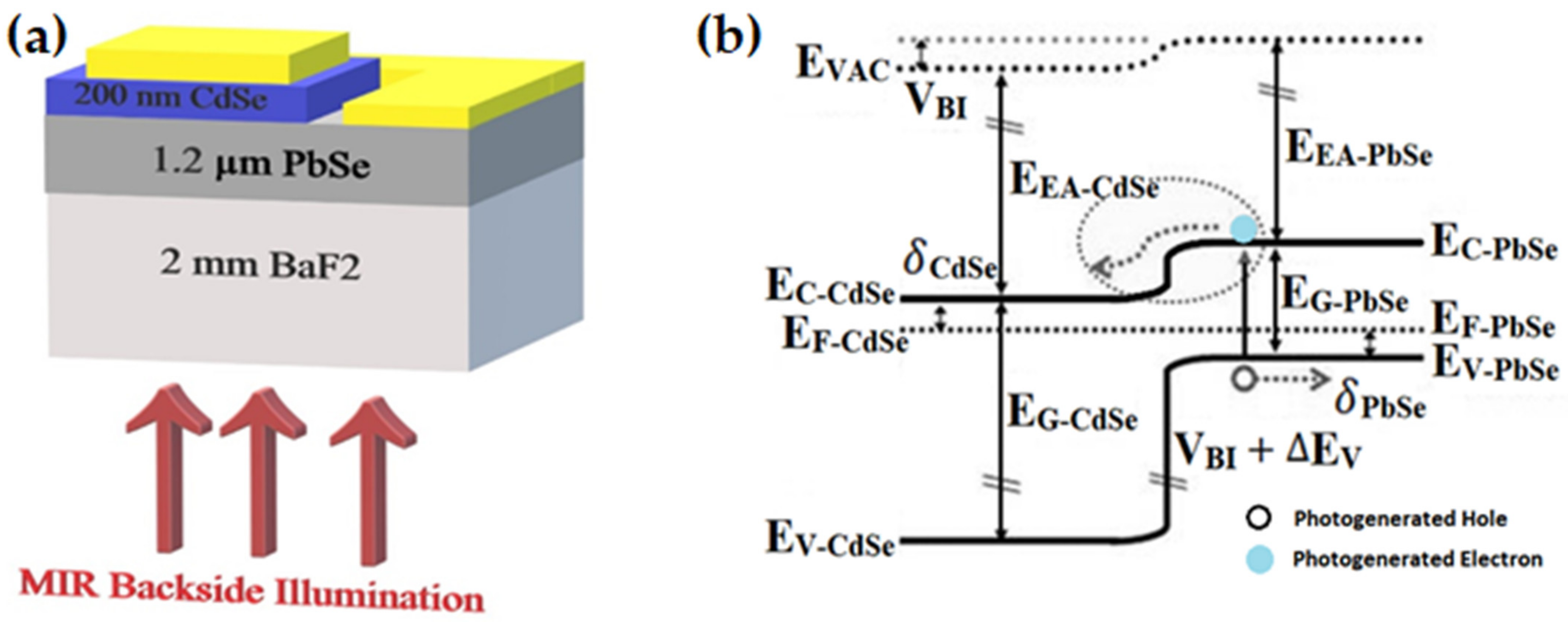
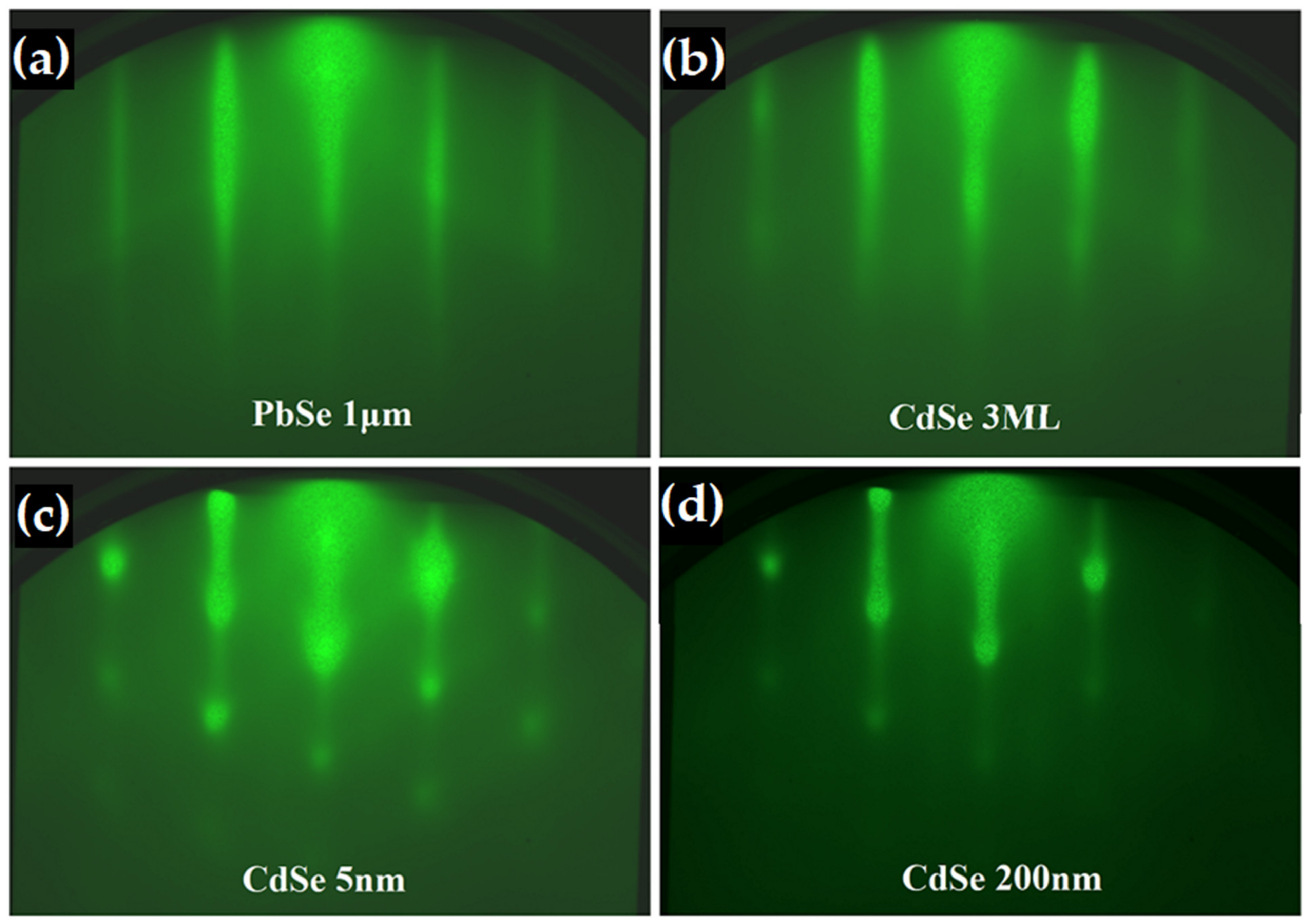
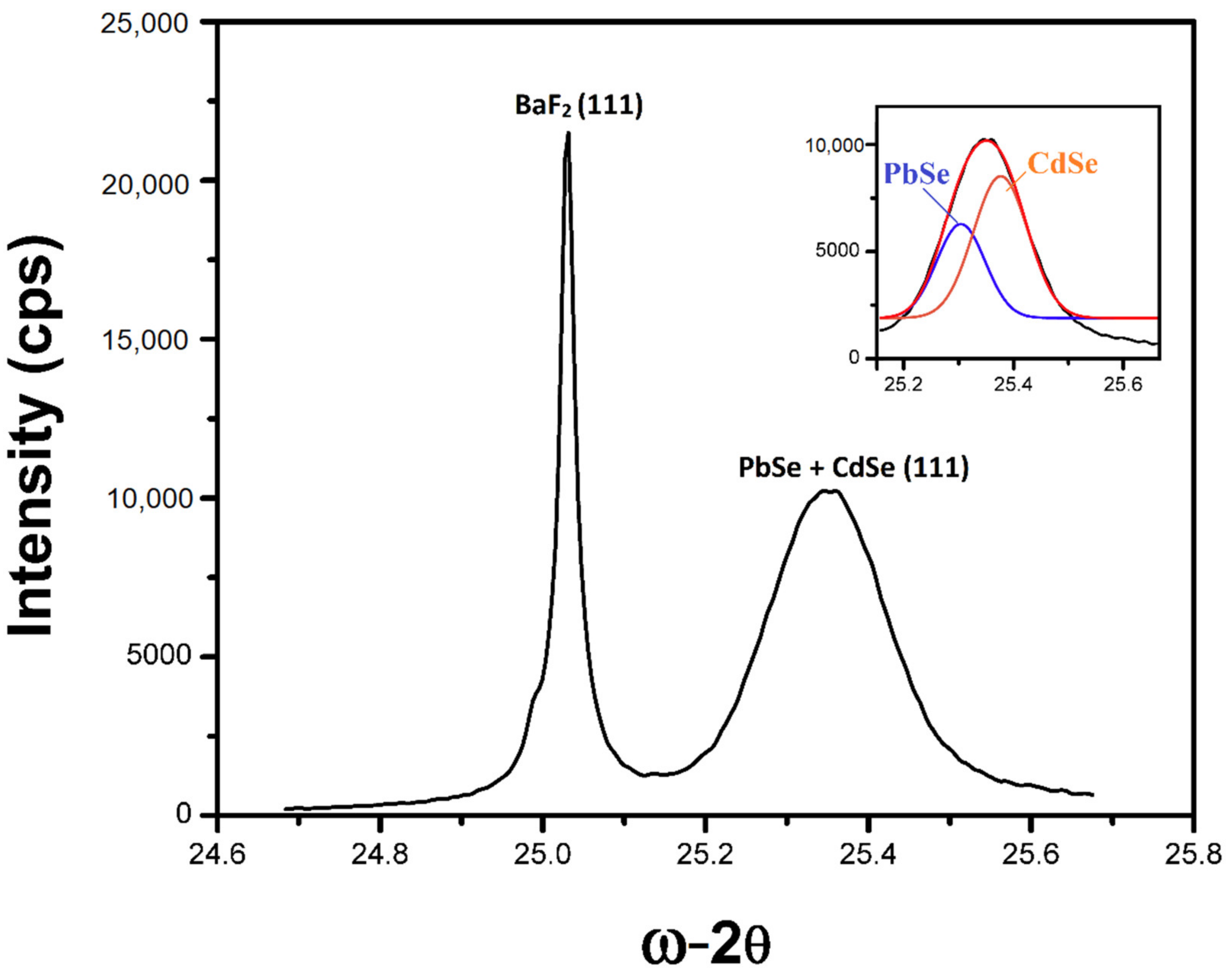
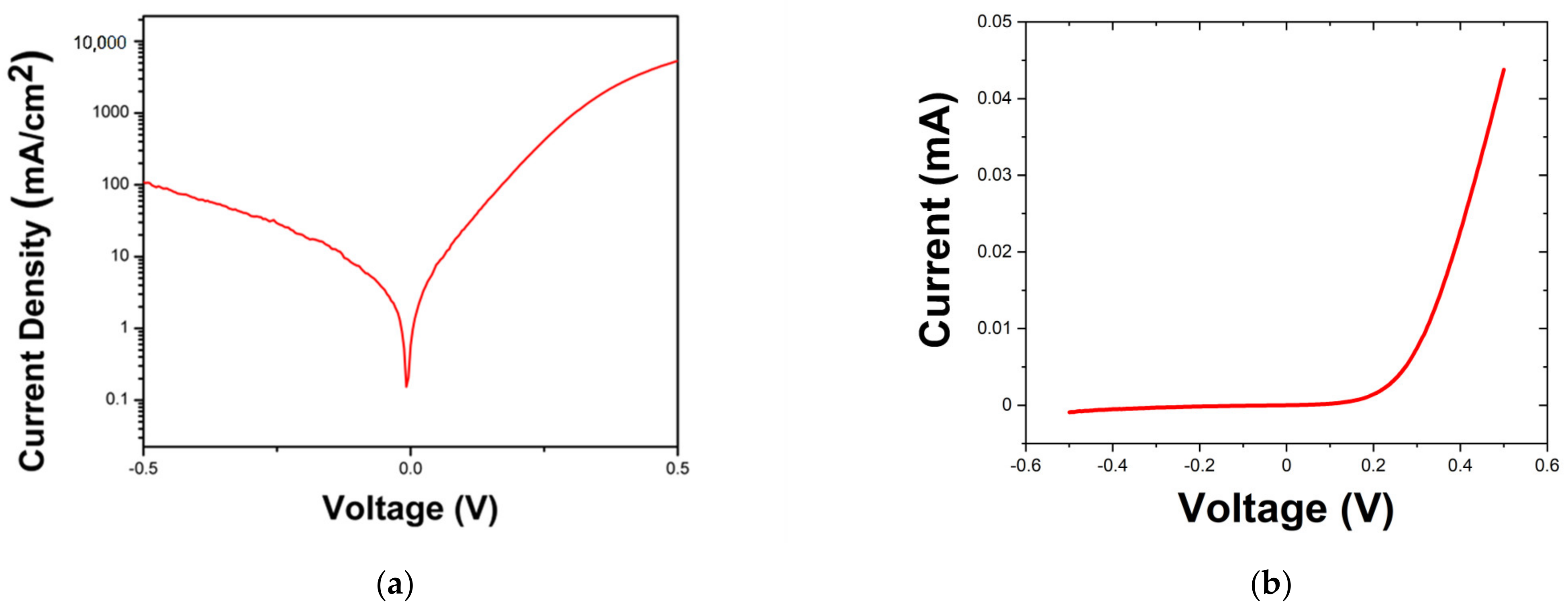
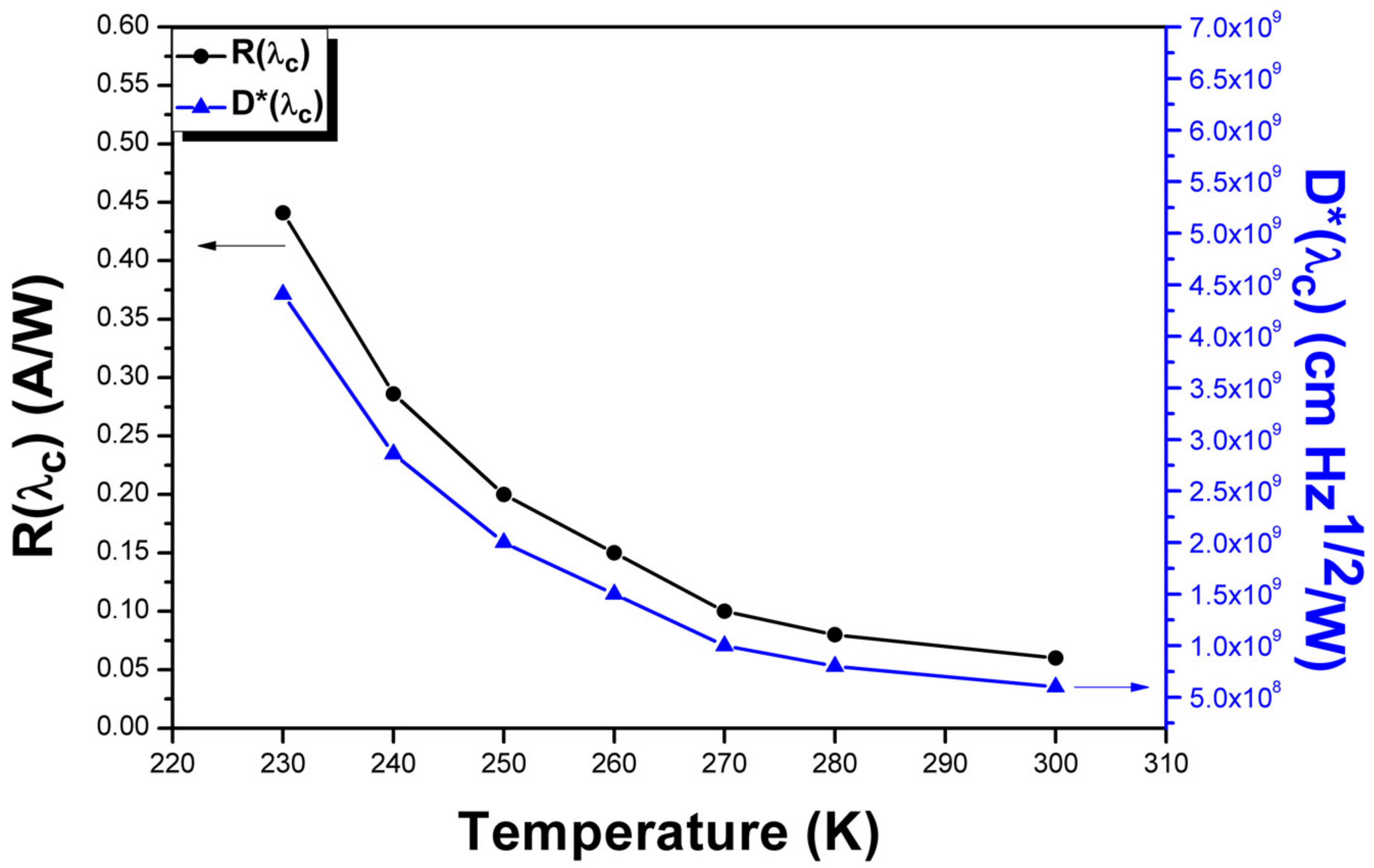
Disclaimer/Publisher’s Note: The statements, opinions and data contained in all publications are solely those of the individual author(s) and contributor(s) and not of MDPI and/or the editor(s). MDPI and/or the editor(s) disclaim responsibility for any injury to people or property resulting from any ideas, methods, instructions or products referred to in the content. |
© 2023 by the authors. Licensee MDPI, Basel, Switzerland. This article is an open access article distributed under the terms and conditions of the Creative Commons Attribution (CC BY) license (https://creativecommons.org/licenses/by/4.0/).
Share and Cite
McDowell, L.L.; Rastkar Mirzaei, M.; Shi, Z. Epitaxial CdSe/PbSe Heterojunction Growth and MWIR Photovoltaic Detector. Materials 2023, 16, 1866. https://doi.org/10.3390/ma16051866
McDowell LL, Rastkar Mirzaei M, Shi Z. Epitaxial CdSe/PbSe Heterojunction Growth and MWIR Photovoltaic Detector. Materials. 2023; 16(5):1866. https://doi.org/10.3390/ma16051866
Chicago/Turabian StyleMcDowell, Lance L., Milad Rastkar Mirzaei, and Zhisheng Shi. 2023. "Epitaxial CdSe/PbSe Heterojunction Growth and MWIR Photovoltaic Detector" Materials 16, no. 5: 1866. https://doi.org/10.3390/ma16051866
APA StyleMcDowell, L. L., Rastkar Mirzaei, M., & Shi, Z. (2023). Epitaxial CdSe/PbSe Heterojunction Growth and MWIR Photovoltaic Detector. Materials, 16(5), 1866. https://doi.org/10.3390/ma16051866





